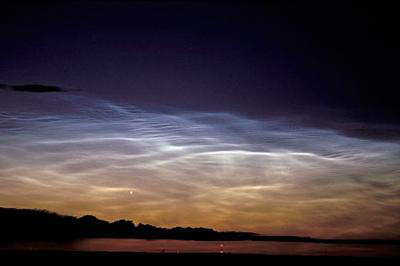NASA Readies Satellite to Scan Earth's Highest Clouds

A NASAspacecraft aimed at probing the mysteries of Earth's highest clouds is gearingup for launch.
The spaceagency's Aeronomy of Ice in the Mesosphere (AIM) satellite is counting down towardsan April 25 space shot to begin the first-ever mission dedicated to trackingEarth's odd noctilucent- or 'night shining' - clouds.
First observedin 1885, the clouds - also known as polar mesospheric clouds (PMC) - are madeof ice crystals hovering some 50 miles (80 kilometers) above Earth. They are onlyvisible at night when they reflect sunlight after the Sun has dipped belowthe planet's horizon.
In recentyears, the previously rare clouds have been found to shine brighter, occur morefrequently and appear at lower latitudes than ever before, leading somescientists to speculate that their behavior may be related to global climatechanges, such as global warming, said Vicki Elsbernd, NASA's AIM mission programexecutive at the agency's Washington, D.C. headquarters, during a Wednesdaybriefing.
Built forNASA by Orbital Sciences and overseen by researchers at Hampton University inHampton, Virginia, the $140million AIM spacecraft is slated to rocket spaceward at 4:26:49 p.m. EDT (2026:49GMT) on April 25 atop an air-launched Pegasus XL rocket. About the size of a smallpiano, the 430-pound (195-kilogram) spacecraft will depart from California'sVandenberg Air Force Base on a two-year mission.
"Othersatellite missions have made measurements of these clouds, but they weren'toptimized and it was not their intent in the beginning," AIM principalinvestigator Jim Russell, of Hampton University, told reporters Wednesday. "Theyprovided information, but not enough to really address the fundamental questionof why [the clouds] form and how they vary."
Because similarcloud formations are seen high above the surface of Mars, researchers hope tobetter understand their implications for life on Earth and future missions tothe red planet, Elsbernd added.
Get the Space.com Newsletter
Breaking space news, the latest updates on rocket launches, skywatching events and more!
"We're veryexcited about the AIM launch," Elsbernd said. "We expect that the new discoveriesfrom AIM, along with our other great observatory missions, will literally rewritethe textbooks in our understanding of Sun and its effects on the Earth's atmosphereand on the solar system."
- IMAGES: Sky Scenes
- Space Station Crew Photographs Mysterious Clouds that Shine at Night
- All About the Earth
Join our Space Forums to keep talking space on the latest missions, night sky and more! And if you have a news tip, correction or comment, let us know at: community@space.com.

Tariq is the Editor-in-Chief of Space.com and joined the team in 2001, first as an intern and staff writer, and later as an editor. He covers human spaceflight, exploration and space science, as well as skywatching and entertainment. He became Space.com's Managing Editor in 2009 and Editor-in-Chief in 2019. Before joining Space.com, Tariq was a staff reporter for The Los Angeles Times covering education and city beats in La Habra, Fullerton and Huntington Beach. In October 2022, Tariq received the Harry Kolcum Award for excellence in space reporting from the National Space Club Florida Committee. He is also an Eagle Scout (yes, he has the Space Exploration merit badge) and went to Space Camp four times as a kid and a fifth time as an adult. He has journalism degrees from the University of Southern California and New York University. You can find Tariq at Space.com and as the co-host to the This Week In Space podcast with space historian Rod Pyle on the TWiT network. To see his latest project, you can follow Tariq on Twitter @tariqjmalik.









